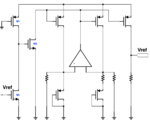Follow along with the video below to see how to install our site as a web app on your home screen.
Note: This feature may not be available in some browsers.

That's why M1 usually is a very long transistor (W/L « 1).
If amp
gain or common mode range is inadequate then you may see
oscillation (if weak @ corner) or tempco issues (if strong @
corner) from startup current continuing to bleed into the
loop.
That's why M1 usually is a very long transistor (W/L « 1).
but it will increase the static power consumption of the circuit. SO maybe I should try another start-up circuit?